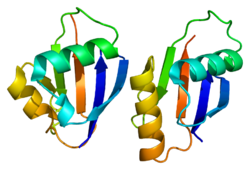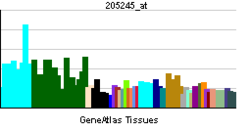- PARD6A
-
Partitioning defective 6 homolog alpha is a protein that in humans is encoded by the PARD6A gene.[1][2][3]
This gene is a member of the PAR6 family and encodes a protein with a PSD95/Discs-large/ZO1 (PDZ) domain and a semi-Cdc42/Rac interactive binding (CRIB) domain. This cell membrane protein is involved in asymmetrical cell division and cell polarization processes as a member of a multi-protein complex. The protein also has a role in the epithelial-to-mesenchymal transition (EMT) that characterizes the invasive phenotype associated with metastatic carcinomas. Alternate transcriptional splice variants, encoding different isoforms, have been characterized.[3]
Interactions
PARD6A has been shown to interact with CDC42,[4][5][2] RAC1,[5][2] ECT2[6] and Protein kinase Mζ.[7][6][2]
References
- ^ Rousset R, Fabre S, Desbois C, Bantignies F, Jalinot P (Mar 1998). "The C-terminus of the HTLV-1 Tax oncoprotein mediates interaction with the PDZ domain of cellular proteins". Oncogene 16 (5): 643–54. doi:10.1038/sj.onc.1201567. PMID 9482110.
- ^ a b c d Noda Y, Takeya R, Ohno S, Naito S, Ito T, Sumimoto H (Mar 2001). "Human homologues of the Caenorhabditis elegans cell polarity protein PAR6 as an adaptor that links the small GTPases Rac and Cdc42 to atypical protein kinase C". Genes Cells 6 (2): 107–19. doi:10.1046/j.1365-2443.2001.00404.x. PMID 11260256.
- ^ a b "Entrez Gene: PARD6A par-6 partitioning defective 6 homolog alpha (C. elegans)". http://www.ncbi.nlm.nih.gov/sites/entrez?Db=gene&Cmd=ShowDetailView&TermToSearch=50855.
- ^ Joberty, G; Petersen C, Gao L, Macara I G (Aug. 2000). "The cell-polarity protein Par6 links Par3 and atypical protein kinase C to Cdc42". Nat. Cell Biol. (ENGLAND) 2 (8): 531–9. doi:10.1038/35019573. ISSN 1465-7392. PMID 10934474.
- ^ a b Qiu, R G; Abo A, Steven Martin G (Jun. 2000). "A human homolog of the C. elegans polarity determinant Par-6 links Rac and Cdc42 to PKCzeta signaling and cell transformation". Curr. Biol. (ENGLAND) 10 (12): 697–707. doi:10.1016/S0960-9822(00)00535-2. ISSN 0960-9822. PMID 10873802.
- ^ a b Liu, Xiu-Fen; Ishida Hiroshi, Raziuddin Razi, Miki Toru (Aug. 2004). "Nucleotide exchange factor ECT2 interacts with the polarity protein complex Par6/Par3/protein kinase Czeta (PKCzeta) and regulates PKCzeta activity". Mol. Cell. Biol. (United States) 24 (15): 6665–75. doi:10.1128/MCB.24.15.6665-6675.2004. ISSN 0270-7306. PMC 444862. PMID 15254234. http://www.pubmedcentral.nih.gov/articlerender.fcgi?tool=pmcentrez&artid=444862.
- ^ Rual, Jean-François; Venkatesan Kavitha, Hao Tong, Hirozane-Kishikawa Tomoko, Dricot Amélie, Li Ning, Berriz Gabriel F, Gibbons Francis D, Dreze Matija, Ayivi-Guedehoussou Nono, Klitgord Niels, Simon Christophe, Boxem Mike, Milstein Stuart, Rosenberg Jennifer, Goldberg Debra S, Zhang Lan V, Wong Sharyl L, Franklin Giovanni, Li Siming, Albala Joanna S, Lim Janghoo, Fraughton Carlene, Llamosas Estelle, Cevik Sebiha, Bex Camille, Lamesch Philippe, Sikorski Robert S, Vandenhaute Jean, Zoghbi Huda Y, Smolyar Alex, Bosak Stephanie, Sequerra Reynaldo, Doucette-Stamm Lynn, Cusick Michael E, Hill David E, Roth Frederick P, Vidal Marc (Oct. 2005). "Towards a proteome-scale map of the human protein-protein interaction network". Nature (England) 437 (7062): 1173–8. doi:10.1038/nature04209. PMID 16189514.
Further reading
- Solecki DJ, Govek EE, Hatten ME (2006). "mPar6 alpha controls neuronal migration.". J. Neurosci. 26 (42): 10624–5. doi:10.1523/JNEUROSCI.4060-06.2006. PMID 17050699.
- Qiu RG, Abo A, Steven Martin G (2000). "A human homolog of the C. elegans polarity determinant Par-6 links Rac and Cdc42 to PKCzeta signaling and cell transformation.". Curr. Biol. 10 (12): 697–707. doi:10.1016/S0960-9822(00)00535-2. PMID 10873802.
- Joberty G, Petersen C, Gao L, Macara IG (2000). "The cell-polarity protein Par6 links Par3 and atypical protein kinase C to Cdc42.". Nat. Cell Biol. 2 (8): 531–9. doi:10.1038/35019573. PMID 10934474.
- Johansson A, Driessens M, Aspenström P (2000). "The mammalian homologue of the Caenorhabditis elegans polarity protein PAR-6 is a binding partner for the Rho GTPases Cdc42 and Rac1.". J. Cell. Sci. 113 ( Pt 18): 3267–75. PMID 10954424.
- Suzuki A, Yamanaka T, Hirose T, et al. (2001). "Atypical protein kinase C is involved in the evolutionarily conserved par protein complex and plays a critical role in establishing epithelia-specific junctional structures.". J. Cell Biol. 152 (6): 1183–96. doi:10.1083/jcb.152.6.1183. PMC 2199212. PMID 11257119. http://www.pubmedcentral.nih.gov/articlerender.fcgi?tool=pmcentrez&artid=2199212.
- Kohjima M, Noda Y, Takeya R, et al. (2003). "PAR3beta, a novel homologue of the cell polarity protein PAR3, localizes to tight junctions.". Biochem. Biophys. Res. Commun. 299 (4): 641–6. doi:10.1016/S0006-291X(02)02698-0. PMID 12459187.
- Strausberg RL, Feingold EA, Grouse LH, et al. (2003). "Generation and initial analysis of more than 15,000 full-length human and mouse cDNA sequences.". Proc. Natl. Acad. Sci. U.S.A. 99 (26): 16899–903. doi:10.1073/pnas.242603899. PMC 139241. PMID 12477932. http://www.pubmedcentral.nih.gov/articlerender.fcgi?tool=pmcentrez&artid=139241.
- Hurd TW, Gao L, Roh MH, et al. (2003). "Direct interaction of two polarity complexes implicated in epithelial tight junction assembly.". Nat. Cell Biol. 5 (2): 137–42. doi:10.1038/ncb923. PMID 12545177.
- Brajenovic M, Joberty G, Küster B, et al. (2004). "Comprehensive proteomic analysis of human Par protein complexes reveals an interconnected protein network.". J. Biol. Chem. 279 (13): 12804–11. doi:10.1074/jbc.M312171200. PMID 14676191.
- Lemmers C, Michel D, Lane-Guermonprez L, et al. (2004). "CRB3 binds directly to Par6 and regulates the morphogenesis of the tight junctions in mammalian epithelial cells.". Mol. Biol. Cell 15 (3): 1324–33. doi:10.1091/mbc.E03-04-0235. PMC 363137. PMID 14718572. http://www.pubmedcentral.nih.gov/articlerender.fcgi?tool=pmcentrez&artid=363137.
- Weyrich P, Kapp K, Niederfellner G, et al. (2005). "Partitioning-defective protein 6 regulates insulin-dependent glycogen synthesis via atypical protein kinase C.". Mol. Endocrinol. 18 (5): 1287–300. doi:10.1210/me.2003-0253. PMID 14976222.
- Liu XF, Ishida H, Raziuddin R, Miki T (2004). "Nucleotide exchange factor ECT2 interacts with the polarity protein complex Par6/Par3/protein kinase Czeta (PKCzeta) and regulates PKCzeta activity.". Mol. Cell. Biol. 24 (15): 6665–75. doi:10.1128/MCB.24.15.6665-6675.2004. PMC 444862. PMID 15254234. http://www.pubmedcentral.nih.gov/articlerender.fcgi?tool=pmcentrez&artid=444862.
- Ballif BA, Villén J, Beausoleil SA, et al. (2005). "Phosphoproteomic analysis of the developing mouse brain.". Mol. Cell Proteomics 3 (11): 1093–101. doi:10.1074/mcp.M400085-MCP200. PMID 15345747.
- Gerhard DS, Wagner L, Feingold EA, et al. (2004). "The status, quality, and expansion of the NIH full-length cDNA project: the Mammalian Gene Collection (MGC).". Genome Res. 14 (10B): 2121–7. doi:10.1101/gr.2596504. PMC 528928. PMID 15489334. http://www.pubmedcentral.nih.gov/articlerender.fcgi?tool=pmcentrez&artid=528928.
- Hirano Y, Yoshinaga S, Takeya R, et al. (2005). "Structure of a cell polarity regulator, a complex between atypical PKC and Par6 PB1 domains.". J. Biol. Chem. 280 (10): 9653–61. doi:10.1074/jbc.M409823200. PMID 15590654.
- Weyrich P, Lammers R, Fritsche A, et al. (2005). "A novel functional polymorphism (-336A/G) in the promoter of the partitioning-defective protein-6alpha gene is associated with increased glucose tolerance and lower concentrations of serum non-esterified fatty acids.". Diabetologia 48 (4): 669–74. doi:10.1007/s00125-005-1688-4. PMID 15744531.
- Ozdamar B, Bose R, Barrios-Rodiles M, et al. (2005). "Regulation of the polarity protein Par6 by TGFbeta receptors controls epithelial cell plasticity.". Science 307 (5715): 1603–9. doi:10.1126/science.1105718. PMID 15761148.
- Barrios-Rodiles M, Brown KR, Ozdamar B, et al. (2005). "High-throughput mapping of a dynamic signaling network in mammalian cells.". Science 307 (5715): 1621–5. doi:10.1126/science.1105776. PMID 15761153.
PDB gallery Categories:- Human proteins
- Chromosome 16 gene stubs
Wikimedia Foundation. 2010.



